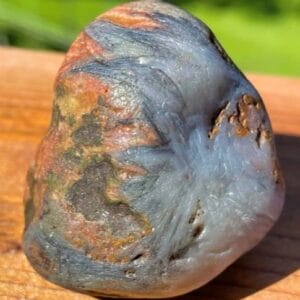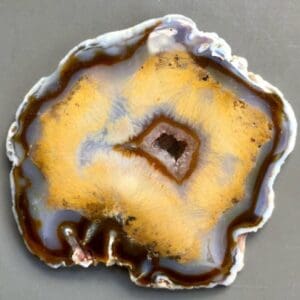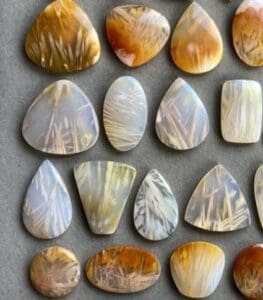Sagenite Agate, or more properly, Sagenitic Agate, is any Agate containing acicular or needle-like minerals or crystal growths that intersect in a grill-like or grid-like manner. These hair-like inclusions are often arranged in sunburst or fan patterns. This makes it fairly easy to identify when attending a rock and mineral show or when you’re out in the field collecting.
Rockhound Fact: Sagenite comes from the Latin and Greek word Sagena, which means “net.”
The nodule below is a great example of the fan pattern on the outside of the agate. If you were to cut slabs off of this nodule, those fan patterns would open up and display a really cool pattern mixed in with the yellow and orange.

Types of Sagenite Agate
There are several types of Sagenite Agate and most of them are named after the location they’re found. You will see a couple of Sagenite Agates named after their patterns or appearance, like Fire Sagenite.
If you’re wondering how the needle-like inclusions become embedded inside of the agate then look no further. This naturally occurring fan-like pattern is created when agate fills cavities within rocks that had previous formations of minerals.
If you need help identifying your Agate or valuing Agate, then click the links.
To make it easy on the die-hard agate collectors, I’ve compiled a short list of the most popular Sagentie Agates below.
Nipoma Sagenite Agate
Nipoma Sagenite Agates that hail from Freddie Quarry in San Luis Obispo County, California, can contain both formations of metallic Marcasite and Sagenite that formed prior to being surrounded by Agate. When we look at this material up close we notice acicular rutile crystals surrounded by agate and that is where the Sagenite name comes from for this species of agate.
Sagenite Fire Agate
Sagenite Fire Agates produce a beautiful iridescent rainbow of colors which is created by the Schiller Effect. This effect is caused by the alternating iron oxide and silica layers that diffract the light which causes the “fire”.
This variety of Sagenite is found in the southwestern USA and northern Mexico. Between 24 to 36 million years ago, these stones were subjected to intense volcanic activity during the Tertiary Period. The Agates formed during this time of vulcanism when iron oxide and hot water saturated with silica repeatedly filled the bubbles and cracks in surrounding rocks.
Rockhound Fact: The original definition of Sagenite was made by Horace Benedict de Saussure in the late 1700s.
Turkish Sagenite Agate
Turkish Sagenite is also known as Stick Agate or Needle Agate. This variety of Agate comes from mines in Ankara, Turkey, hence the name. Like all other Sagenite Agate, Turkish Sagenite features stick-like formations surrounded by Agate. So, what makes Turkish Sagenite different from other Sagenite Agates? For one, the Agate formed as a pseudomorph after Aragonite crystals lined the edges of a pocket.
One unique feature of Turkish Sagenite is the Druzy Quartz often found inside the nodules when you cut them open with a diamond rock saw.

Sagenite Agate Geode
These are fairly easy to identify because you get the best of both types of rocks. For one, you get a layer of Agate around the edge of the geode and Sagenite inclusions. Towards the center of the geode, you’ll notice Druzy Quartz crystals. If you’re wondering where most of these come from then look no further than Turkey.
Rock and mineral dealers will sell these as polished slabs or a nodule cut in half with a polished face.

Plume Sagenite Agate
Plume Agate is more common than many people realize and the highly sought-after Priday Plumes, Del Norte, Mexican Plume, and Graveyard Point are a must-have among rock hounds. If you’re a connoisseur of Plume Agate and you really enjoy Sagenite Agates then you’re in luck.
The Sagenite inclusions occur when iron oxide minerals grow inside of the Plume Agate while it is in a liquid state. If you have the opportunity to cut and polish one of these then you’ll notice a pin cushion pattern when the tops of the Sagenite needles break through the surface of the Agate.
Red Sagenite Agate
Red Sagenite Agate derives its name from the high amounts of iron oxide present when it was formed. These iron oxides create the red, orange, and yellow colors you see in the Agate. Add in the hair-like needle inclusions and you have a stunning Red Sagenite Agate. Lapidary artists love working with this material because of the warm colors and intricate patterns which allow them to cut one-off cabochons.
Where Is Sagenite Agate Found?
Sagenite Agate is found in the United States and Turkey. If you live on the west coast or the Pacific Northwest then the material is easily sourced. The Turkish material is a little harder to find but the Tucson Gem and Mineral show should have nodules and cabochons to view and purchase.
- Identify Enstatite - March 12, 2024
- Identify Cerussite - March 3, 2024
- Identify Bytownite - February 18, 2024
